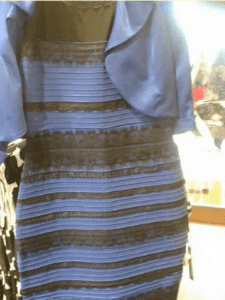Priming
When Is It Reasonable to Kill?
A viral photo of a dress show us why self-defense claims can be problematic.
Posted September 3, 2020 Reviewed by Lybi Ma
Back in 2015 (remember when there was a time before global pandemics?), a washed-out photograph of a dress ignited a viral firestorm.

Some saw a white and gold dress, while others saw black and blue. More than 10 million tweets referenced the dress as debates over its true colors raged within social circles. Admittedly, even my own wife and I saw the dress differently. I saw white and gold, but she saw black and blue. I was incredulous at hearing that she perceived the dress in such a way. I had just assumed that the “black and blue” crowd was comprised of deranged internet people. But my own wife?! To me, the dress was so clearly white and gold. I couldn’t see anything else.
And yet, as per usual, my wife was ultimately correct. The true colors of the dress were eventually revealed in a subsequent photo (with less ambiguous lighting). Much to my chagrin, it really was black and blue.
“The dress” thus offers a stark reminder that two human beings can view the exact same stimuli with two very different perspectives. One tried-and-true method for influencing human perception is the realm of psychological priming. In brief, priming is a technique in which the introduction of one stimulus influences how people respond to a subsequent stimulus. Priming works by activating an association or representation in memory prior to another stimulus being introduced. This phenomenon can occur absent conscious awareness, and yet it can have an extraordinary effect on our perception.
For example, in one seminal 2004 study, participants were subconsciously primed with certain visuals prior to viewing an image of a gun that initially appeared very degraded, but gradually became more clear. Participants primed with images of African American faces were able to more quickly identify the image of a gun compared to individuals primed with other visuals.

Today, the United States exists in a state of hyper-polarization. Whether fueled by a visceral hatred of the current presidential administration or rather a deep-seated fear that progressive policies are corrupting the nation, a large contingent of our society is already primed to view stimuli in a way that accords with their preconceived notions. The phenomenon of confirmation bias can also influence individuals to view certain stimuli in ways that fit within their existing worldview.
Recently, video captured 17-year-old Kyle Rittenhouse as he shot and killed two individuals in Kenosha, Wisconsin during a protest (or riot, depending on your perception!). Much of the public reaction to the video footage fell into two polar opposite camps. On the one hand, some individuals vilified Rittenhouse as a murderous terrorist. Indeed, he has now been charged with first-degree murder for both of the killings. But on the other hand, many championed him as a hero, justifiably defending himself from a violent mob. In fact, nearly $400,000 has been donated to Rittenhouse’s legal defense fund at the time of this writing.
The Rittenhouse case is certainly not the first time that video footage has elicited widely discordant perceptions. For example, the video of Ahmaud Arbury’s killing that received national attention was actually released by a criminal defense lawyer who had consulted with the shooters. Ironically, this lawyer released the video because he believed it clearly exonerated the shooters. As it turned out, many in the public viewed things well… quite differently.
How Discordant Perceptions Affect Claims of Self-Defense
Discordant perceptions in response to the same stimuli present an interesting legal dilemma. In the legal world, there is a “reasonable person” standard upon which countless laws rely. The reasonable person is a hypothetical individual in society who exercises average care, skill, and judgment in conduct and who serves as a comparative standard for determining liability.
Claims of self-defense hinge on the reasonable person standard. Generally speaking, self-defense is permitted if the user of force has a reasonable belief that force was necessary to prevent harm. When it comes to deadly defensive force, the user of force must have a reasonable belief that there is an imminent threat of great bodily harm or death.

Put simply: an individual is permitted to kill in self-defense if a reasonable person in the same situation would have believed there was an imminent threat of great bodily harm or death.
Many might find the reasonable person standard concerning given its inherent subjectivity. But the reality is that the law often exists in shades of “grey.” In fact, this avoidance of black-and-white regulation is often by design. Seldom do human actions fall neatly within rigid and formulaic parameters. Given that we are not robots, human behavior is best interpreted through nuance and context. In theory, the jury exists to review the totality of facts in a trial and act as the final assessor of "reasonableness." After all, a jury is supposed to be a cross-section of the community chosen at random. Who better to decide what is reasonable than a group of supposedly reasonable people?
While the purpose of the jury might be sound, in practice the system can lead to great controversy. For example, through a process called voir dire, attorneys on both sides are able to select the actual jury from the pool of prospective jurors. These prospective jurors are put in front of the attorneys and asked about their backgrounds, potential biases, and any previous knowledge about the facts of the case. The questions attorneys can ask are limited in scope, but a tactful attorney will use their questions to uncover characteristics or experiences to suggest that the prospective juror might favor their side of the case. Attorneys can dismiss jurors they don’t like either “for cause” (for example, a prospective juror is biased because they are a police officer in a case about police brutality) or via a “peremptory challenge.” Using a peremptory challenge, the attorney can dismiss a prospective juror for literally no reason at all.
While voir dire applies to both sides of the case and thus attempts to strike a balance, the reality is that juries often end up specially selected to favor one party over the other. Sometimes, tactful attorneys are able to change the entire location (or "venue") of a trial, such that the entire pool of potential jurors is more favorable to their client. Such was the case in the Rodney King trial, which was moved to Simi Valley—a strongly conservative and pro-law enforcement suburb outside of Los Angeles (which, oddly enough, also happens to be my hometown). Despite the egregious video footage of Mr. King's beating at the hands of police, the Simi Valley jury acquitted the officers.
As our nation seemingly grows more divided and people become increasingly primed to perceive stimuli in ways that reinforce their worldview, the concept of the "reasonable person" begins to lose meaning. What does "reasonable" really mean if it depends on the already-biased eye of the perceiver? Put more clearly: If Rittenhouse is able to be judged by a jury of conservatives, the odds are better that he will be acquitted of murder on grounds of lawful self-defense. Should a panel of progressives decide his fate, he would be more likely to be found guilty and face the possibility of life imprisonment.
Does such a disparate outcome really comport with the notion of equal justice?
References
Eberhardt, J. L., Goff, P. A., Purdie, V. J., & Davies, P. G. (2004). Seeing black: Race, crime, and visual processing. Journal of Personality and Social Psychology, 87, 876–963.




